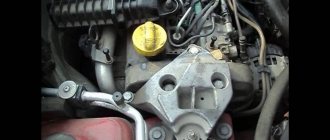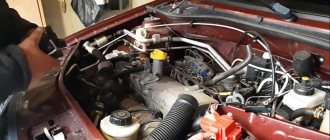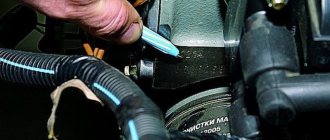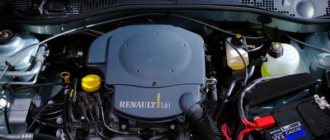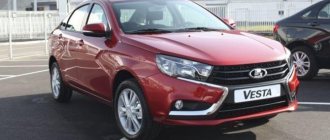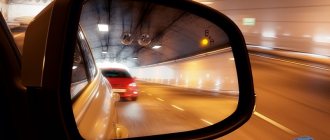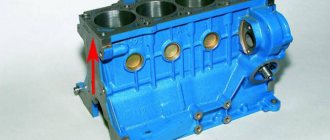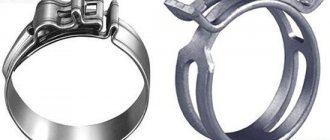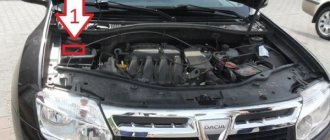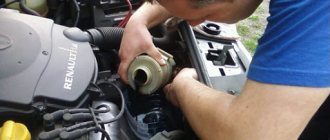How to find out the engine number?
Engine number nearby
Because the numbers and letters on the power unit do not necessarily tell you what exactly is encrypted there. For this purpose you need to use a hint.
The first line contains an alphanumeric index consisting of 7 characters. The first three characters indicate the type of engine, while the others indicate the number of valves, volume and injection system.
Under this line there is a seven-digit index, which will be the specific number of this specific instance of the motor. It must be used for recording in warranty documents.
When cleaning the engine number, do not use iron brushes.
Be careful. Do not use iron brushes when “cleaning” the engine number. You should use only rust removers, such as Tsinkar, or analogues when the Logan body is galvanized.
The more than just the mileage of the engine, the more terrible it will be seen and the more difficult it is to make out the numbers; it’s great that the Traffic Police does not currently ask to check the number of this element when registering.
Passport data of the car Renault Logan 2004-2015 Gasoline
It must be used for recording in warranty documents. Do not use iron brushes when cleaning the license plate motor, be careful.
You should only use rust removers, such as Tsinkar or analogues; by the way, Logan’s body is galvanized. Do not use rough objects for cleaning.
Use only rust removers, such as Tsinkar or analogues; by the way, Logan’s body is galvanized. The greater the mileage of the engine, the worse it will be visible and the more difficult it will be to distinguish the numbers; it’s good that the traffic police no longer require checking the number of this element during registration.
If possible, do this on different printed media so that you can always find the information you are interested in.
VIN code location
In addition to the VIN code, it is necessary to record other data about the car. If possible, do this on several cardboard media so that you can always find the information you are interested in. This will help in choosing a product and purchasing the right part.
The VIN code indicates the model of the engine installed on the car.
Passport data is located on a special identification plate. The location of its fixation is located on the right pillar of the front passenger door.
As for the identification number, which can also be called a VIN code, it is located on the dashboard of the engine department
You can find it, of course, by simply opening the hood. Right in front of your eyes, closer to the car’s interior, you will see a gray plate stretched horizontally.
Renault Sandero where is the engine number - we explain in order
We are looking for the engine number for Renault Logan, where has it disappeared?
Renault Logan cars have become incredibly popular in our country. So, there are more and more questions about their operation. In particular, the owners of this car may have a question about where the
Renault Logan engine number, as well as some other passport data.
Renault Logan 2 – Engine number K4M, K7M, H4M
However, the main problem lies under the hood. Owners of previous Logans know how easily and quickly engine numbers rot on their engines. In 3-4 years, the symbols could not only become covered with a coating of corrosion, but disappear forever without a trace, so that neither WD-40 nor zinc lotions could help. The second generation did not lose this drawback, but the rate of destruction clearly decreased sharply. It is especially dangerous to clean the markings with sandpaper. Let me remind you that the law contains an article for the deliberate destruction of forensic markings. Fortunately, the new amendments allow you to re-register a car with a rotten license plate. Not without unnecessary movements, of course, but it’s possible.
On the K4M (1.6, 103 hp) and K7M (1.6, 82 hp) Logan 2 power plants, the engine number is located in almost the same place: in the front of the unit, under the manifold, closer to the gearbox. In the case of a 16-valve unit, it is extremely difficult to establish visual contact with the platform, even with an inspection mirror. In order to clean the symbols from rust, you will have to completely dismantle part of the air duct, otherwise a hand with a rag will not fit through.
Engine number K7M (1.6, 82 hp) Engine number K4M (1.6, 103 hp)
The only engine with which there will definitely be no problems with corrosion and dirt is the Nissan H4M unit (113 hp). The engine number on it is printed vertically on an inclined platform in the front of the engine close to the gearbox:
Engine number HR16DE-H4M (113 hp)
Renault Logan 2 – Weaknesses and breakdowns
Logan 2nd generation
Next, we consider options for finding license plates on an updated car.
K7M, K4M and H4M
On the eight-valve 1 6 V8 (K7M) and sixteen-valve 1.6 V16 (K4M) engines, the unit numbers are located in front and to the left along the machine, under the manifold. V16(K4M) you may have to remove part of the air duct. The model and engine number lose their shape over time under the influence of external factors.
The working volume of these engines is 1 6 liters.
Modified engines after restyling with the same markings
The engine designations have not changed. Accordingly, the instruction manual indicates the same location of the number.
The situation is best with the Nissan H4M engine. The area for the number is located vertically, near the junction of the gearbox and is not subject to dust and dirt.
VIN code location
In addition to the VIN code, you also need to record other data about the car. If possible, do this on several paper media so that you can always find the information you are interested in. This will help in choosing and purchasing the right part.
By VIN code you can find out the model of the engine installed on the car
Passport data is located on a special identification plate. The location of its fixation is located on the right pillar of the front passenger door.
As for the identification number, which can also be called a VIN code, it is located on the engine compartment panel
You can find it by simply opening the hood. Directly in front of your eyes, closer to the car interior, you will see a light gray plate, elongated horizontally.
What does the information on the signs mean?
Vehicle identification data
If we talk about the first information plate (which is circled in an oval), then it contains data that will help in finding parts.
| Below this sign is another sticker. If you read it from top to bottom, you can see:
|
By the engine number you can determine whether it has been replaced or repaired. Such a request can be sent through any Renault dealership. Upon request, you can find out whether the engine has undergone a major overhaul, for example, due to wear or bent valves.
The engine number is not readable: how to remove rust
If the sign is almost rotten, which is not uncommon, do not use harsh mechanical force. Scrapers, blades, sandpaper excluded.
The numbers are engraved very shallowly and you risk destroying the rest. The same applies to the rust converter. The last outlines can simply be washed away along with the corrosion.
For cleaning, WD-40, oil (you can use waste oil), “Silit Plaque and Rust” product, and rags are suitable. And you also need to be patient, which will most likely be rewarded. You can improve the clarity of barely outlined contours using chalk. They need to rub the engraving and then go over it with a rag. The chalk will remain in the tiny indentations and enhance the contrast.
Components of the code
This cipher consists of 17 characters, including Latin letters and Arabic numerals. But there are three exceptions, these include the symbols “I”, “O”, “Q”. Why are these letters not involved in the formation of the VIN code? The answer to this question is very simple. The characters “O” and “Q” themselves are very easy to confuse with “0”. Yes, and correcting “O” and “0” to “Q” is not at all difficult. The same applies to the letter “I”, which is not only easy to confuse with “1”, but also easy to correct, for example, by making “L”, “F”, “E” or some other symbol. Therefore, to make life more difficult for scammers, these letters were excluded.
The VIN structure can be divided into three main parts. It all starts with WMI, which consists of the first three characters. This part characterizes the vehicle manufacturer. Having deciphered the first character, you will find out in which geographical area the car was produced; the second character hides more specific information, namely the country. The third character will already provide information about a specific manufacturer. In some cases, you can see the number “9” in the last position of the WMI part, this means that less than 500 cars are produced per year. But information about the manufacturer will then be hidden behind signs 12–14.
Decoding Renault VIN code
Next is the VDS group, it includes six characters. Typically, this part of the code provides information about the characteristics of the vehicle - body type, model range, equipment, etc. Sometimes the gross vehicle weight and safety systems may even be indicated. The 9th position of the VIN, where the control number is hidden, deserves special attention. If fraudsters have a small chance to fake the remaining symbols, then during verification this particular number will not confirm the authenticity of the marking.
The last, closing group is called VIS. It includes 8 designations. After reading them, you can find out about the model year of the car, especially for the American manufacturer. In general, this information is of a very individual nature, for example, for most cars produced in the USA, the 10th position indicates the next model year, starting from July 1. This has a completely logical explanation, because many cars first go to the exhibition, and only next year for sale. Thus, with the onset of the new calendar year, there are no “last year’s” products left in the warehouse. But it is worth noting that many manufacturers may not be clever with numbers and indicate the actual year of manufacture.
Decoding Logan's VIN code
You can carry out the procedure yourself.
| Designation (letter, number in order) | Description |
| 1,2,3 | Manufacturer code |
| 4 | Body type |
| 5 | The lineup |
| 6,7 | Individual engine code for each model range |
| 8 | Geographical location of the manufacturer |
| 9 | Gearbox type |
| 10 | Year of issue |
| 11-17 | Serial number |
Below are the links:
Why does almost everyone have to check their VIN?
The VIN code was invented so that you could check whether the car was stolen and whether any dubious stories had happened to it. Essentially, it acts as an identification number for a car. Therefore, when purchasing a vehicle, you must also check its code, especially when it comes to expensive or exclusive brands. You should not save on this, even if you take a car from a car dealership, because there are known cases of fraud in them too. You will also find out the exact release date and the number of previous owners.
Expert opinion Ruslan Konstantinov Expert on automotive topics. Graduated from Izhevsk State Technical University named after M.T. Kalashnikov, specializing in “Operation of transport and technological machines and complexes.” More than 10 years of professional car repair experience.
Every modern car has a unique identification number or VIN (Vehicle Identification Number), which contains important information. In fact, after deciphering the code, you can find out the full history of the vehicle. Identification numbers are regulated by the ISO 3779-1983 standard. In compliance with this regulation, cars are produced in 24 countries. The VIN code consists of 17 characters, which contain both letters and numbers. Previously, all domestically produced cars had two unique numbers; the designations were applied to the engine and the body. These numbers were often replaced by hijackers, but this practice was ineffective, since any examination could reveal the scammers. Now such signs are no longer used, only the number on the body remains, which is the VIN code. Similar designations were introduced in the mid-90s.
Vehicle VIN
However, this is not the only, although the main purpose of the number. This code has been assigned by the manufacturer to absolutely every vehicle since 1980. By deciphering it, you can find out the engine type and equipment. Therefore, you can be guided by alphanumeric designations when purchasing spare parts.
Advantages and disadvantages of power units
The 1.6 and 16-valve engine differs from the newest modifications; they are the absence of a mechanism for regulating valve timing; this engine design has significantly reduced the dynamic capabilities of the car. But the advantages remain excellent maintainability and durability, that is, increased engine life, thanks to simple design solutions from the manufacturer.
- the cylinder volume increased (1.6 liter engine), which made it possible to increase power in tandem with torque and improve the dynamic characteristics of the model;
- The output of the unit increased by 11% (up to 82 “horses” for the 8-valve version), this engine design led to an increase in torque to 132 Nm;
- the cooling system has undergone adjustments (the need for this modification is caused by an increase in engine power);
- the cooling circuit did not receive any fundamental design changes, and its elements were modified in order to achieve greater performance, for which some new components were integrated, which led to an increase in the service life and efficiency of the system, especially in critical operating modes;
- power increase up to 102 hp. With. achieved thanks to the use of new components in the cylinder-piston group units and valve mechanism:
- the number of valves has doubled (from 8 to 16), which ensured better filling of the combustion chambers with the mixture and led to an increase in power and dynamic capabilities;
- The service life of the motor has increased significantly due to the use of parts made of new, more durable alloys;
- After applying the previously mentioned design solutions in the updated engines, Renault Logan developers managed to achieve significant fuel efficiency:
- 1.5 liters at a distance of 100 km for a 1.6 engine with 16 valves;
- 1.0 liter in the case of 8-valve engine versions.
All these innovations made it possible to essentially make the 1.6 liter engine. more modern (especially the 16-valve version), the engine life has become longer. Although the developers did not apply progressive and innovative design solutions, this modernization of engines for Renault Logan still made it possible to attract a large army of new potential customers to the updated model.
- increasing the performance level of the intake and exhaust systems, which was a necessary measure to bring engines to the advanced level of environmental standards;
- the use of new elements in the cooling circuit, which significantly improved the efficiency of its operation;
- replacement of the generator with a version of increased performance for the Renault Logan model, which made it possible to cope with increased loads on this unit (now the power varies depending on the model’s configuration)
Considerable experience in operating Renault cars with all three types of liquid-cooled engines allows us to draw up a fairly objective picture of their strengths and weaknesses, and in the two models K7J and K7M these characteristics are almost identical, and only the K4M engine has significant differences due to more modern technological solutions, and which one is better is up to the buyers to decide.
Advantages of K7J and K7M:
- low cost and simplicity of engine design;
- reliability: confirmed service life is more than 400 thousand km;
- versatility and maintainability;
- ease of maintenance;
- high torque;
- good “elasticity” of engines, equal to 1.83.
Disadvantages of K7J and K7M:
- relatively high fuel consumption;
- instability of speed when idling;
- the absence of hydraulic compensators in the design, as a result - the need for constant adjustment of the valves (after 20-30 thousand km);
- “bending” of valves when the timing belt suddenly breaks;
- increased “fluidity” of crankshaft oil seals;
- poor reliability of cooling system elements;
- noisy and prone to vibration.
The advantages of the K7M model over the K7J include only an increase in maximum power by 12% and maximum torque by 11%. But the 1.6 liter internal combustion engine also pays for these advantages with an increased appetite of 4.5%, so which is better is a moot point.
How to avoid becoming a victim of scammers?
Such unusual places are chosen for a reason. Of course, a number of difficulties arise in finding and disassembling it, although in all cases the VIN should be readable. But if it is in an easily accessible place, then scammers will be able to interrupt some signs without making much effort. For example, from “5” it is easy to make “6”, the letter “P” can be easily changed to “R”, and anything can happen with the number “1”.
In addition, some manufacturers themselves give the scammers a free hand and, instead of squeezing out this code with a special stamp, they began to apply it using standard technology without deforming the sheet. And such code is not at all difficult to fake. The fact is that in the first case, due to the deformation of the sheet material, it was quite problematic to “correct” any symbol, and if the code was also difficult to access, then it was completely impossible.
Embossed code on sheet material
Usually, due to basic human laziness, scammers process only the most easily accessible option. In addition, you should be wary of scratches, traces of dirt and other defects. Check the fastening of the sign; it is usually secured with small, neat rivets. If you notice any traces of interference, it is better to refuse the purchase, as there is a high probability that it will bring headaches instead of joy.
Engine
LADA LARGUS cars are equipped with gasoline, in-line, 4-cylinder, 8- and 16 - valve engines with a displacement of 1.6 liters. with 2 or 4 valves per cylinder.
For engine identification number plate locations, see here. The ratio of installed engines and gearboxes in trim levels can be found here.
Until mid-2016, the car was equipped with Renault K7M (8-cl) and K4M (16-cl) engines. Since 2016, their modern analogues produced by AvtoVAZ began to be installed. Accordingly, the K7M was replaced by the VAZ-11189 , and the K4M was replaced by the VAZ-21129 . The engines are distinguished by a lightweight ShPG, automatic timing belt tensioner, metal cylinder head gasket, body kit and supports.
Since 2022, Lada Largus CNG (with LPG) will be equipped with 21129 CNG dual-fuel engines.
Depending on the vehicle configuration, there are several options for installing auxiliary equipment on engines:
- a car with power steering;
— a car with non-power steering and air conditioning;
— a car with hydraulic power steering;
— a car with hydraulic power steering and air conditioning.
The main parameters and characteristics of the engines are given in tables 1 and 2.
| Options | Engine model | |
| RENAULT, K4M | RENAULT, K7M | |
| Injection type | Electronically controlled multipoint fuel injection | |
| Fuel type | Gasoline Premium-95 GOST 51105-97 | |
| Number and arrangement of cylinders | 4, in-line | |
| Number of valves | 16 | 8 |
| Cylinder operating order | 1-3-4-2 | |
| Direction of rotation of the crankshaft (from the camshaft drive mechanism side) | ||
| right | ||
| Cylinder diameter/piston stroke, mm | 79,5×80,5 | |
| Working volume, cm 3 | 1598 | |
| Compression ratio | 9,8 | 9,5 |
| Toxicity standards | Euro 4 | |
| Power at 5500 rpm, kW (hp) | — | 62 (84) |
| Power at 5750 rpm, kW (hp) | 77(105) | — |
| Maximum torque, N.m (at rpm) | 148 (3750) | 124 (3000) |
| Volume of oil poured into the engine lubrication system, including oil filter, l | 4,8 | 3,3 |
| Options | Engine model | |
| VAZ 11189 | VAZ 21129 | |
| Engine volume, cm3 | 1596 | 1596 |
| Number and arrangement of cylinders | 4, in-line | 4, in-line |
| Number of valves | 8 | 16 |
| Maximum power, kW (min") | 64*(5100) | 78*(5800) |
| Maximum torque, N*m (min*1) | 140*(3800) | 148*(4200) |
| Cylinder diameter, mm | 82 | 82 |
| Piston stroke, mm | 75,6 | 75,6 |
| Compression ratio | 10,3 | 10,45 |
| Injection type | Electronically controlled multipoint fuel injection | |
| Octane number of gasoline | At least 92 | At least 92 |
| Transmission | Mechanical 5-speed | |
| Gearbox designation | JR5, 21809 | |
| Wheel drive | 4×2 | |
| Drive wheels | Front | |
| Environmental class | 5 | |
| Engine weight | ≈111.0 kg | 110.7 kg |
Engine manufactured by AVTOVAZ 1.6 l.
ENGINE 1.6 (8 valve, 84 hp)
The K7M engine is a gasoline, four-stroke, four-cylinder, in-line, eight-valve, overhead camshaft. The operating order of the cylinders is: 1–3–4–2, counting from the flywheel. Power supply system – distributed fuel injection (emission standards Euro 4).
The engine, gearbox and clutch form the power unit - a single unit mounted in the engine compartment on three elastic rubber-metal supports. The right support is attached to the bracket on the top cover of the gas distribution mechanism drive, and the left and rear ones are attached to the gearbox housing. On the front of the engine (in the direction of vehicle movement) there are: exhaust manifold, oil filter, low oil pressure warning sensor, coolant pump supply pipe, spark plugs, generator, power steering pump, air conditioning compressor.
At the rear of the engine there are: an intake manifold with absolute pressure and intake air temperature sensors, a throttle assembly with a throttle position sensor and an idle speed regulator, a fuel rail with injectors, a knock sensor, a starter, and an oil level indicator. On the right is the coolant pump, timing gear and coolant pump drive (toothed belt), auxiliary drive drive (V-ribbed belt). On the left are: flywheel, thermostat, crankshaft position sensor, coolant temperature sensor. On top is the ignition coil, oil filler neck. The engine cylinder block is cast from cast iron, the cylinders are bored directly into the block. At the bottom of the cylinder block there are five crankshaft main bearing supports with removable caps, which are attached to the block with special bolts. The holes in the cylinder block for the bearings are machined with the covers installed, so the covers are not interchangeable and are marked on the outer surface to distinguish them (the covers are counted from the flywheel side). On the end surfaces of the middle support there are sockets for thrust half-rings that prevent axial movement of the crankshaft.
The crankshaft main and connecting rod bearing shells are made of steel, thin-walled, with an anti-friction coating applied to the working surfaces. Crankshaft with five main and four connecting rod journals. The shaft is equipped with four counterweights, integral with it. The counterweights are made on the continuation of the “cheeks” of the engine crankshaft. Counterweights are designed to balance the forces and moments of inertia that arise during the movement of the crank mechanism during engine operation. To supply oil from the main journals to the connecting rods, there are channels made in the journals and cheeks of the shaft. At the front end (toe) of the crankshaft there are installed: an oil pump drive sprocket, a timing gear drive pulley and an auxiliary drive pulley. The toothed pulley is fixed on the shaft with a protrusion that fits into a groove on the toe of the crankshaft and protects the pulley from turning. The auxiliary drive pulley is similarly fixed on the shaft.
The connecting rods are steel, I-section, processed together with the covers. The covers are attached to the connecting rods with special bolts and nuts. The piston pin is steel, tubular in section. The pin, pressed into the upper head of the connecting rod, rotates freely in the piston bosses. The piston is made of aluminum alloy. The piston skirt has a complex shape: barrel-shaped in the longitudinal section, oval in the transverse section. In the upper part of the piston there are three grooves machined for piston rings. The two upper piston rings are compression rings, and the lower one is oil scraper. Compression rings prevent gases from escaping from the cylinder into the engine crankcase and help remove heat from the piston to the cylinder. The oil scraper ring removes excess oil from the cylinder walls as the piston moves.
ENGINE 1.6 (16 valve, 105/102 hp)
The K4M engine is a gasoline, four-stroke, four-cylinder, in-line, sixteen-valve, with two overhead camshafts. The operating order of the cylinders is: 1–3–4–2, counting from the flywheel. Power supply system – distributed fuel injection (emission standards Euro 4). The engine, gearbox and clutch form the power unit - a single unit mounted in the engine compartment on three elastic rubber-metal supports. The right support is attached to the upper cover of the gas distribution mechanism drive, and the left and rear ones are attached to the gearbox housing.
General recommendations for engine maintenance
Note: The information below is for general information purposes only and is not specific to any car brand.
Fortunately, automakers understand that in the world there are not only developed countries like the USA, Germany, Japan, France, etc., but also developing countries like Iran, Nigeria, Angola, Sudan, and now Russia, so cars, those supplied there are often very different from promising technology, and, according to our realities, for the better.
This entire preface was written for a reason. If we are talking today about the health of the engine and its longevity, then the first item on the agenda will, of course, be the choice of the power unit, so that then we can simply carry out scheduled maintenance without any repairs, replacement of components, vessels with warranty departments of dealer organizations and other similar inconveniences that are common drag on for a very long time, especially in our country.
Video
Source
Where to look for the treasured ciphers?
To decipher the Renault VIN code, you must first find it. For the entire global automotive industry, there are several locations for this cipher. Most often, it is enough to look through the windshield from the outside at the instrument panel; it is marked on the left side of it. Or look at the left A-pillar located at the front. The number is also applied to the door sills, cylinder block or its head. If you still haven’t found the code, then it’s time to examine the partition between the passenger compartment and the engine compartment. In car frame structures, which are typical for SUVs, the VIN may be indicated on the side members.
VIN on the side member
Renault cars are most often characterized by the following locations of the identification code:
- at the very bottom of the arch next to the driver's seat (you will have to open the door),
- under the carpet under the right seat,
- on the surface of the cylinder block,
- on the front passenger seat pillar (between the hinges).
Very often this code is duplicated. It is stamped on a special table, which is placed under the hood or on the surface of the air intake box shelf. This is probably the only place convenient for viewing.
Renault Logan VIN code
The Renault Logan 1 VIN number is located on the central edge of the body in the engine compartment. On some trim levels it is duplicated by a branding on the windshield, bottom left.
Next, let's look at how the identification number is decrypted, using the following characters X7LLSRAHH5H123456 as an example:
- the first three characters indicate the code of the direct manufacturer according to the international classification;
- the fourth character indicates the body type (sedan);
- the fifth and sixth inform about the accepted designation of the car according to factory standards;
- A – availability of an airbag . If instead of the indicated symbol there is 4, then there are no airbags;
- HH - 1.6 liter power unit . If there is a combination of characters GH – ICE V1.4;
- 5 – encryption of the year of manufacture of the car.
VIN location
The VIN code of Renault Logan 2nd generation is located in a different location. It is applied to the transverse floor reinforcement directly in the interior space . The symbols are hidden under the right front passenger seat.
To gain access to them, a special cutout is made in the carpet.
Where is Renault Logan assembled for Russia?
Checking and selection of components
Getting the VIN for any Renault car is quite simple. Today there are many services that provide similar services. You just need to fill out the appropriate windows, and within a few days you will receive a detailed transcript. It is better to contact only official websites to avoid becoming a victim of scammers. Of course, this service is not free, but is a few hundred rubles comparable to the possible losses that a damaged or stolen car will bring?
Also, if you break through this code, you can accurately select spare parts, because it also indicates the equipment. Recently, most stores provide a similar service; you can either indicate the make, model, year of manufacture and engine size of your vehicle, or simply fill out the column reserved for the VIN code. The last option will eliminate the possibility of error.
Decoding the vin number
Using the VIN code, you cannot determine the date the car left the assembly line. To do this, you will need a special program or contact the manufacturer. However, decoding the VIN of a Renault Duster provides certain information.
The first three numbers and letters are an international code assigned to a specific manufacturer. For Renault vehicles, the VIN number begins with:
- VF1, VF2 and VNE (France);
- VF6 (France, not found in the Duster model);
- VS5 and VSY (Spain);
- VF1 (Türkiye);
- GA1 (Madagascar).
Renault puts VMK at the beginning of the VIN code on sports models, and VFA on Alpina cars. That is, such designations cannot be found in Duster. Crossovers assembled at Russian factories are marked as X7L.
The next letter indicates the body type of a particular vehicle. In relation to the Duster, in this part of the VIN there is an “H”, indicating a station wagon. The next two letters “SR” indicate that the car belongs to the Logan/Sandero/Duster family.
The seventh position can be “A”, “D”, “G”, “H”. Each of these letters is assigned to a specific configuration in which the crossover is produced.
Currently reading: Renault Logan how much horsepower
The eighth position of the VIN code hides the engine type:
- A - 1.6-liter 108 hp;
- T, 8 - 1.6-liter 102 hp;
- G, J – 2-liter 135 hp;
- D, V – 1.5-liter diesel with 65-110 hp.
In the ninth position there are numbers or letters that hide the type of transmission that is used on the Renault Duster:
- 4, 5, H, K, G – 5-speed manual transmission;
- N, G – 6-speed manual transmission;
- B, D, 6 – automatic transmission.
The last 7 digits are the production number. Each car is assigned its own designation, so you can distinguish two identical cars from each other.
The VIN code is often used to accurately identify a vehicle when purchasing used models. The discrepancy between the number in the technical documentation and what is stamped on the body indicates a stolen car.
